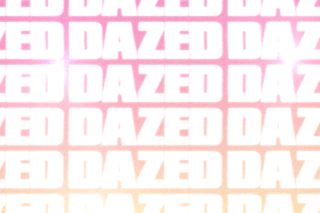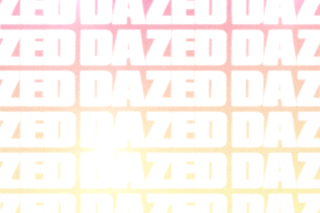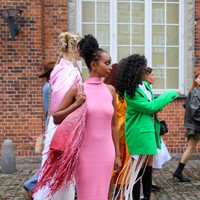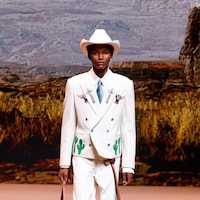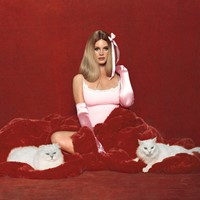As a means of escaping their everyday lives, a growing community of teens are dreaming of an idyllic life in the country
“Put a finger down if you know how to knit, sew, or crochet,” a TikTok video by @cncealingflwrs begins. “Put a finger down if you own more than five sweaters,” she continues. “Put a finger down if you own more than three flower-printed clothing items... Have flowers or dried flowers around your room…Or love the aesthetic of fungi and mushrooms.” The list goes on before she asks: “How many fingers do you have left? Let me see!”
You might not have realised if you’re not up on your TikTok-born trends, but @cncealingflwrs’ video offers a succinct checklist of aesthetic traits associated with a growing community called ‘cottagecore’. Overlapping with a host of other style subsets and underground fandoms including goblincore, grandmacore, fairycore, and dark academia, cottagecore as it is now known was initially established in late 2018 (or 1918, depending on who you ask).
“It revolves around the romanticised idea of cottage life in the countryside or the woods and encompasses things like baking, gardening, reading, farm animals, and picnics,” Rory, 18 tells us. Currently a student living in Alberta, Canada, her Instagram is an aspirational moodboard filled with cute pictures of teapots, baby animals, and women in frilly dresses. “I always wanted to have a little goat but my mom never let me,” reads the caption of one post. “Who wants to raise goats and other animals on a farm with me?” Head to her highlights and you’ll find more of the same, with small personal triumphs including a freshly baked batch of vegan cupcakes and a recipe for homemade strawberry milk on the line-up.
Whether you enter the cottagecore world through TikTok, Instagram, Reddit, or Tumblr, what becomes apparent almost immediately is the dizzying levels of whimsy and nostalgia that fuels its community. The antithesis of the acid-bright e-girls whose visuals dominated social media in 2019, the cottagecore aesthetic is much softer: think Little House on the Prairie-esque faded floral blouses, frilled dresses that could have been lifted directly from Picnic at Hanging Rock, and a whole host of thrift store-acquired knitted cardigans and sweater-vests paired with faded mom-jeans.
Along with the rose-tinted and charmingly faded imagery that embodies the subculture’s aesthetic, captions are written in the style of period drama dialogue or historic prose, as cottagecore enthusiasts reach back to a time when technology and environmental woes did not exist.
Though cottagecore may be a relatively new community, its members’ yearning for the past isn’t all that strange when you consider teenage vinyl collectors, 16-year-old Beatles fanatics, and the countless teens who idolise the likes of Anna Karina and Jane Birkin. Its aesthetic, too, harks back to the early 2010s, when smock dresses and filling your room with flea market-foraged curios was a widespread trend. What sets it apart, however, is the distinct lack of an “I was born in the wrong era” narrative.
With some calling out the trend for romanticising a period in history which saw land taken from indigenous people by white homesteaders, though much of the subculture’s appeal lies in its undeniable escapism, cottagecorers are keen not to gloss over the problems of the era much of their inspiration comes from – when violence against people of colour and LGBTQ+ people was rife. Though admittedly the scene, for now, is not racially diverse, instead of war reenactments, an ignorant yearning for years gone by, or playing out the past scene by scene, cottagecore reimagines it as a safer, more inclusive space.
In the early 1900s, when residing in a cottage was a way of life “the LGBTQIA+ community were ridiculed and not accepted in society,” Nancee, 19 explains. The Ohio college student lives on a farm and as a cisgender lesbian is cognizant of the delineation between fantasy and reality. “Today, we know that this is a community where we can be ourselves without worrying about being harassed.”
“Eventually, I plan on moving out of Florida to be somewhere with more access to nature. I love trees, forests, springs and waterfalls. I would love to have a wildflower field and a natural hot water bath to sit and watch the sunset in” – Annette, 20
Once you wade past the European-centric folklore, a penchant for strawberries and homemade pies, and the kind of love for Studio Ghibli that borders on obsession, what may on the surface feel like just another short-lived TikTok trend is actually a supportive community of often marginalised young genderqueer people seeking acceptance.
Many videos on TikTok that are hashtagged with #cottagecore are also accompanied by another tag, #wlw – short for “woman-loving-woman” or women who love women. “It’s basically cottagecore but with two girls that like each other,” Melanie, a 15-year-old from Florida explains. On TikTok, a video where she describes her “cottagecore fantasy” garnered over 306,000 views.
“Hear me out, hear me out,” Melanie starts, looking directly into the camera, her flower crown glowing in the direct sunlight. “What if we got so fed up with society that we decided we wanted to move away, and we did move away, we moved away into the forest and we lived in a cottage and we had a little garden and we interacted with animals and both of us dance under the moonlight… and we were both girls.” Though the video isn’t the first of its kind, the desire behind both it and its counterparts is very real. “The idea of someday finding calmness and peace somewhere away from the fast pace of life is ideal in my book,” she confirms.
Even more than escapism, fantasy, or leaving the city behind, cottagecore is also about rejecting the male gaze. “The LGBTQ+ community is so heavily sexualised and fetishised that it’s refreshing to just have something that we've curated from the ground up,” Nancee continues. “It’s such a warm, safe spot, that we feel welcomed and feel like we belong.”
For others, indulging in this aesthetic is something akin to self-care. Minty, an 18-year-old from Bristol creates art, practices witchcraft, and enjoys wearing vintage clothing. Her appreciation for cottagecore goes back to Sylvanian Families, a series of anthropomorphic animal collectable figurines created by Japanese gaming firm, Epoch. “Simple things that make me happy, like planting some seeds or looking at lovely pictures or baking... it’s self-care because it’s so personal and wholesome,” she explains. “It’s removed from a lot of the worries of modern society and is this safe space of butterflies, moss, and herbal tea.”
As the aesthetic relies on nature, it comes as no surprise that many of its enthusiasts are activists themselves. On her Instagram, Minty often poses next to graffiti that reads, “Meat Hurts” and other posts show her at rally holding a sign emblazoned with the words, “Destroy the patriarchy, not the planet.”
Some take these environmental cues as a lesson on our addiction to modern technology. Of course, the irony is that this aesthetic is played out on social media. Annette, a 20 year-old from Florida admits she’s made peace with this duality. “Modern tech is super beneficial but can be super destructive to mental well-being,” she explains over Instagram. “Eventually, I plan on moving out of Florida to be somewhere with more access to nature. I love trees, forests, springs and waterfalls. I want to go hiking and adventuring. I would love to have a wildflower field and a natural hot water bath to sit and watch the sunset in.”
These long rambling fantasies that follow otherwise succinct answers aren’t uncommon when speaking with these cottagecore enthusiasts. But right at this moment, their dreams of living in a cabin surrounded by fields of mushrooms are nothing but greener pastures. As the world goes into lockdown and many of us are instructed to self isolate or even mandated to quarantine, leaving the house and enjoying nature is further away than ever before.
“Being quarantined is so harmful to mental health,” Annette bemoans before reminding us that simply “feeling the sun warm your skin, or the wind rustle through your hair or clothes is an amazing grounding technique.” But while isolation has stifled her creativity and made runs to the art store non-existent, with her community just a few phone screen-taps away, she remains hopeful, encouraging people to get outside and connect with nature (albeit in a safe way). “It can be easy to give in to the isolation, but even just sitting outside for a little while can enhance your mood,” she concludes. “Even if that means just going out at night to look at the stars for a second.”




